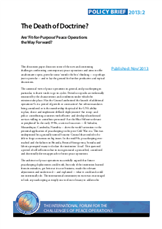POLICY BRIEF 2013:2 The Death of Doctrine? Are ‘Fit-for-Purpose’ Peace Operations the Way Forward?

This discussion paper discusses some of the new and continuing challenges confronting contemporary peace operations and aims to offer an alternative optic, provoke some ‘outside the box’ thinking – or perhaps just to provoke – and to lay the ground for further productive and topical discussions.
The canonical view of peace operations in general, and peacekeeping in particular, is that it tends to go in cycles. Periods or epochs are informally measured by the characteristics and conditions under which the missions take place.
- Has the Council authorized the launch of additional operations?
- Is it a period of growth or contraction?
- Are robust mandates being considered or is the membership skeptical of the UN’s ability to plan, direct and implement difficult deployments?
- Are troop- and police- contributing countries with effective and developed uniformed services willing to contribute personnel?
- Are the Blue Helmets relevant or peripheral?
In the early 1990s, a series of successes – El Salvador, Mozambique, Cambodia, Namibia – drew the world’s attention to the potential application of peacekeeping in the post-Cold War era. This was underpinned by a generally united Security Council that tended to be able to forge consensus on big issues. In the mid-90s, peacekeeping overreached and the failures in Rwanda, Bosnia-Herzegovina, Somalia and Liberia prompted many to declare the institution ‘dead’. This spawned a period of self-reflection that in turn generated a proscribed, considered and doctrinally-driven approach to future peace operations.

